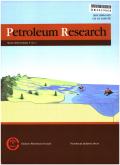Nanoparticles stabilized foam fluid for hydraulic fracturing application of unconventional gas reservoirs: A review of the properties, progress and future prospects
IF 4
Q1 Earth and Planetary Sciences
引用次数: 0
Abstract
Nanoparticles stabilized foam fracturing fluid is an emerging technology in the field of hydraulic fracturing for the unconventional reservoirs. Hydraulic fracturing, commonly known as fracking, is a process used to extract oil and gas from the unconventional reservoirs, such as shale formations. This study has reviewed contiguous improvement in the properties of foam fracturing fluid by the effective formulation of surfactant, polymer, and nanoparticles. Compared to conventional fracturing fluids (slick water and polymer), nanoparticles stabilized foam fracturing fluids exhibit superior proppant-carrying capabilities, ensuring better penetration into micro-fractures and enhanced contact with the reservoir matrix, reduce water usage, and minimize formation damage. Foam structures at different scales, i.e., the interface between air-water and liquid film has been discussed in depth to elaborate on the mechanisms that maintain the stability of foam film. The effects of nanoparticles for improving the foam stability and liquid drainage are deliberated to throw light on the strength and limitations of the current review work for better knowledge of foam structure. This review work is on the advancement of nanoparticles foam fluid focuses on significant analyses, problems, future scope, and applications. The various knowledge gaps and conflicting observations have been identified that give the range of our studies. The technical challenges of using foam-based fracturing fluids were also explored. Maintaining foam stability at the high pressures and temperatures experienced in unconventional reservoirs is a critical challenge. The potential for foam collapse or degradation could undermine its effectiveness in delivering proppants and stimulating fractures.
纳米颗粒稳定泡沫液在非常规气藏水力压裂中的应用:性质、进展及展望
纳米颗粒稳定泡沫压裂液是非常规油藏水力压裂领域的一项新兴技术。水力压裂法,通常被称为水力压裂法,是一种用于从页岩地层等非常规储层中提取石油和天然气的方法。本研究回顾了表面活性剂、聚合物和纳米颗粒的有效配方对泡沫压裂液性能的持续改善。与常规压裂液(滑溜水和聚合物)相比,纳米颗粒稳定泡沫压裂液具有更好的支撑剂携带能力,能够更好地渗透到微裂缝中,增强与储层基质的接触,减少用水量,最大限度地减少地层损害。深入讨论了不同尺度下的泡沫结构,即空气-水界面和液膜界面,阐述了维持泡沫膜稳定性的机理。研究了纳米颗粒在提高泡沫稳定性和液体排水方面的作用,从而揭示了当前综述工作的强度和局限性,从而更好地了解泡沫结构。本文对纳米颗粒泡沫流体的研究进展进行了综述,重点阐述了纳米颗粒泡沫流体的重要分析、存在的问题、未来的发展方向和应用前景。各种各样的知识差距和相互矛盾的观察结果已经确定,这给了我们的研究范围。此外,还探讨了泡沫基压裂液的技术挑战。在非常规油藏的高压和高温下保持泡沫的稳定性是一个关键的挑战。泡沫破裂或降解的可能性可能会影响支撑剂的输送和压裂效果。
本文章由计算机程序翻译,如有差异,请以英文原文为准。
求助全文
约1分钟内获得全文
求助全文
来源期刊

Petroleum Research
Earth and Planetary Sciences-Geology
CiteScore
7.10
自引率
0.00%
发文量
90
审稿时长
35 weeks
 求助内容:
求助内容: 应助结果提醒方式:
应助结果提醒方式:


